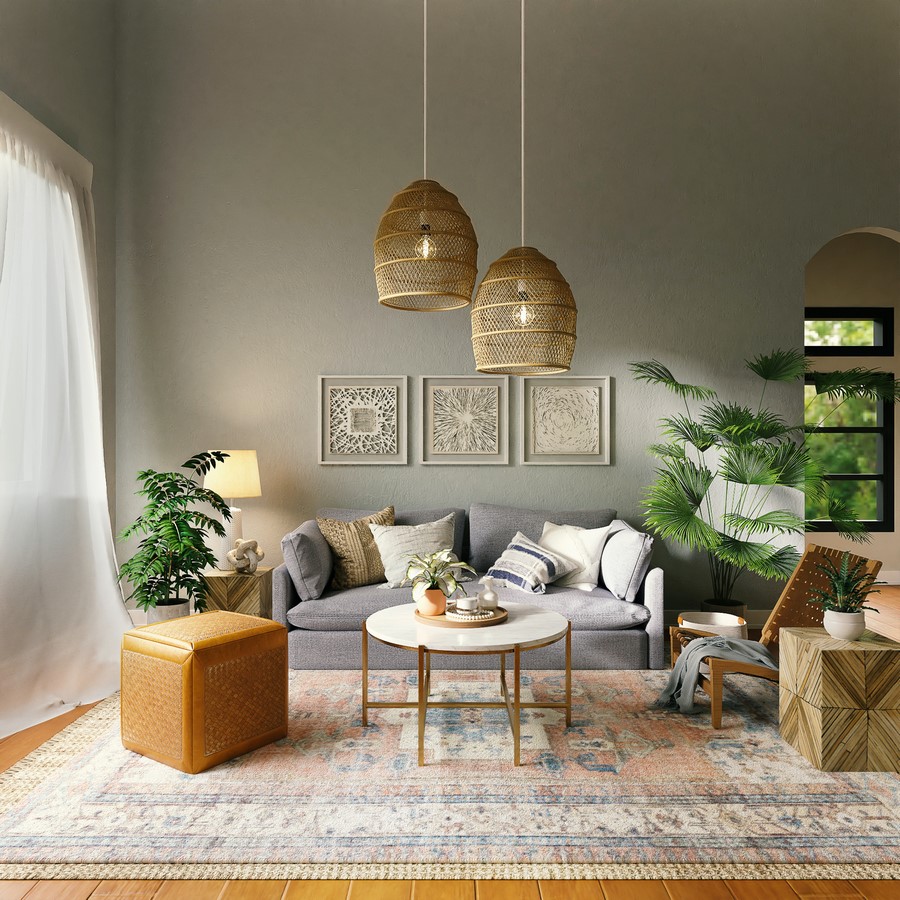It is no surprise to say that an interior environment affects the health of a person because 90% of the time is spent indoors today.
After the start of the COVID-19 pandemic, there has been more discussion about wellness, cleanliness, and the psychology of space. The term “healing spaces” is also no longer uncommon as there is much appeal in seeking and building a homey, and healthy habitat.

As we increase our understanding of how built environments can impact humans, there are three focus areas that architects and interior designers can experiment on and ideate from to develop design strategies on how to apply the research behind wellness.
Indoor Air Quality

As many people live in cities today, buildings have gone beyond the human scale and soared higher. There are stories about people living in spaces with no windows because every square meter or square inch is maximized today. On the other hand, some populations live by the beach or have views of the riverside where they always have access to a cool breeze – both natural and man-made from the air conditioning unit.
The sight of humidifiers is also another item that’s becoming as mainstream as masks and hand sanitizers. But one thing that’s becoming rare in the city is natural ventilation. Natural ventilation is not always available in some urban spaces. So, indoor air quality is one thing that almost everyone has to face and manage whether one lives in a studio unit or townhouse.
Having a high level of air quality will greatly improve the health of people indoors. Designers can consider choosing materials with low to no VOCs (Volatile Organic Compounds). Installing and proper placement of vents in the kitchen can also help to avoid cross-contamination of spaces. For example, one person might be cooking in the kitchen while another person is cleaning using products with bleach or ethanol in the toilet. Considering the function of spaces as well as the air circulation is an important consideration when developing the interior layout as well. To complement that, having proper storage for cleaning products can also separate exposure to contaminants in the air.
Another thing to consider is humidity. Humidity is the level of water vapor in the air. High humidity means that there is an increased amount of water vapor in the air. In certain climates, high humidity can affect an interior space by releasing VOCs into the air. It also traps particles in the air and keeps it close to the ground, not allowing the air to clear. It also affects the body by making it difficult for sweat to evaporate. And high humidity also encourages mold and fungus to grow as well as viruses and germs. Humidifiers and dehumidifiers are some tools to deal with this. Choosing materials carefully such as specifying easy-to-clean surfaces and ventilation placement can also be studied to suit the interior environment to ensure its health.
Noise Pollution

Traffic, cars, and construction sound all make up urban life. People don’t always have the option to move into a quiet area or avoid the hustle and bustle of the city on top of a high-rise tower. More often than not, the noise pollution becomes a buzzing behind the ear.
Working remotely or working in an office, it is also difficult to separate the sounds of the outdoors from seeping inside. The sound might also come from the inside such as the sound of the fan or the air conditioning unit. Careful observation of the sounds inside would be a first step in reducing the noise. One popular solution to deal with noise is acoustic panels. They can help to control the reverberation of sound within a space.
Another way to absorb these sounds is the cushions of furniture. Each item of furniture can be calculated by simulating it through computer programs available today to see how it can add up to reduce noise pollution.
A more permanent and more pricey solution is to specify double-pane windows. These are double glass panels on windows that are useful for condominium units or houses that face the street. They can act as a barrier and supplement the acoustic panels inside the space too.
Ergonomics

Lastly, ergonomics also affects the well-being of people indoors. Most of the time spent at work or home is time spent sitting. Not having the proper measurements, or the right fit, and sitting in an uncomfortable posture can lead to back pain.
As designers, learning anthropometry which is the knowledge of human proportions, and applying it to everyday products and furniture will improve people’s lives indoors. And applying ergonomics, which is the process of designing workplaces or systems to fit the people who use them, designers and homeowners can do this by learning the measurements of the users of the space. This will help in designing or selecting the chair that fits, the table height that prevents injury or neck pain, and even the lumbar support to address posture health.
While indoor air quality, noise control, and ergonomics might sound like obvious considerations in making a healthy space, they can be overlooked and be an underrated suggestion. But it shows that small changes in the air, in the sounds, and the dimensions of our tools matter in designing a space that addresses health and wellness.
References
Dohrmann (2014). What is Ergonomics? – Dohrmann Consulting. [online] Dohrmann Consulting. Available at: https://www.ergonomics.com.au/what-is-ergonomics/.
Gattupalli, A. (2022). Healthy Spaces: The Rise of Wellness Design in 2022. [online] ArchDaily. Available at: https://www.archdaily.com/994250/healthy-spaces-the-rise-of-wellness-design-in-2022.
Harrouk, C. (2020). Psychology of Space: How Interiors Impact our Behavior? [online] ArchDaily. Available at: https://www.archdaily.com/936027/psychology-of-space-how-interiors-impact-our-behavior.
HealthPartners (2017). Can high humidity make you sick? [online] HealthPartners Blog. Available at: https://www.healthpartners.com/blog/humidity-can-make-you-sick/#:~:text=Humidity%20measures%20the%20amount%20of.
Macomber, J.G.A. and J.D. (2020). We spend 90% of our time inside—why don’t we care that indoor air is so polluted? [online] Fast Company. Available at: https://www.fastcompany.com/90506856/we-spend-90-of-our-time-inside-why-dont-we-care-that-indoor-air-is-so-polluted.
Meira, S. (n.d.). How to Design Healthy Spaces. [WebinarJam] Available at: https://ugreen.io/healthy-spaces-webinar/ [Accessed 17 Sep. 2023].
Image Sources
Images from Spacejoy, Josh Wilburne, CHUTTERSNAP, Linh Nguyen via Unsplash














